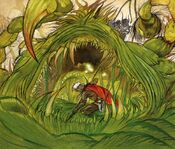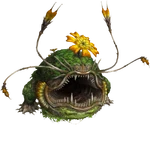Template:Sideicon Template:Sideicon Template:Sideicon

Oh, shut up and help me remodel the Ochu page!

An Ochu artwork from the original Final Fantasy.
The Ochu (オチュー, Ochū?, lit. Otyugh) is a recurring enemy in the Final Fantasy series. Its appearance is usually that of a large plant with either two or four thorny arms and a ring of flower petals that somewhat resemble a skirt. It commonly uses Sleep and Poison-based attacks.
Appearances
Final Fantasy
Ochus (the name appeared in the original NES translation as Ocho) are a common sight when riding the canoe to Mount Gulg, and also make appearances in the Citadel of Trials. Neochus live in the Flying Fortress.
Final Fantasy VII
The Ho-chu is an exclusive enemy to the Battle Square. There exists in the game coding for an enemy formation consisting of one Ho-chu in the Ancient Forest. It seems to be treated as a special encounter, since it is not possible to escape from it.
Before Crisis -Final Fantasy VII-
Final Fantasy VIII
Ochus are scattered in various places around the world, including the forest in which the second Laguna sequence takes place and the Island Closest to Heaven.
Final Fantasy IX
The Conde Petie Mountain Path has Ochu enemies on it.
Final Fantasy X
Lord Ochu is an optional boss which can be fought in the Kilika Woods. Later on Ochus are encountered along the Moonflow road. Lastly, Mandragoras are encountered in the Mt. Gagazet caves and on the road leading to Zanarkand.
Final Fantasy X-2
Ochu's become regular enemies after Chapter 4 and Drowsy Ochu's overtake the Mushroom Rock road during Ch.3 and all Ochu's can later be fought in Via Infinito in Ch.5.
Sphere Break
Template:FFX-2 Coin
Final Fantasy XI
There is a creature known as an Ochu in Final Fantasy XI; however, this creature is actually in the Morbol family, more commonly called Malboros. They inhabit certain plateaus of Rolanberry Fields.
The Rafflesia inhabiting the areas around Windurst during the Shadowreign era more closely resemble the traditional Ochu.
Final Fantasy XIII
Ochu from Final Fantasy XIII.
Ochu appear in Final Fantasy XIII as both a regular enemy and as a mission. In this game, they are accompanied by Microchu in battle. A stronger variety, known as the Neochu is also fought in a mission, and is accompanied by several Picochu in battle.
Final Fantasy XIII-2
Ochu appears as a sidequest target in Archylte Steppe -Year Unknown-. It appears with several Microchus.
Final Fantasy XIV
Final Fantasy Tactics
The Ochu is a member of the Malboro species.
Final Fantasy Tactics Advance
The Ochu and Neochu appears in this game as Malboro type enemies, they are more powerful than average Malboros and are only fought once as part of a special mission. According to the mission description, they are not native to Ivalice.
Final Fantasy Crystal Chronicles
Final Fantasy Crystal Chronicles: My Life as a King
Final Fantasy All the Bravest
The gaping maw and lethal tentacles almost ruin the beautiful flower atop its head.
In-game description.
The Ochu appears in Final Fantasy All the Bravest as an enemy encountered on the Archylte Steppe. It uses Feeler and drops the Dragon Whisker.
Etymology
Like much of the bestiary from the original Final Fantasy, the "Ochu" comes from Dungeons & Dragons; specifically, it is the otyugh. The name in Japanese (and transliterations) comes from the pronunciation; it is pronounced with a short O and T (practically to a ch), making the pronunciation close to "o-chuugh". "オチュー" is the closest the katakana system can get to representing the sound.
Template:Enemies Template:Sideicon







